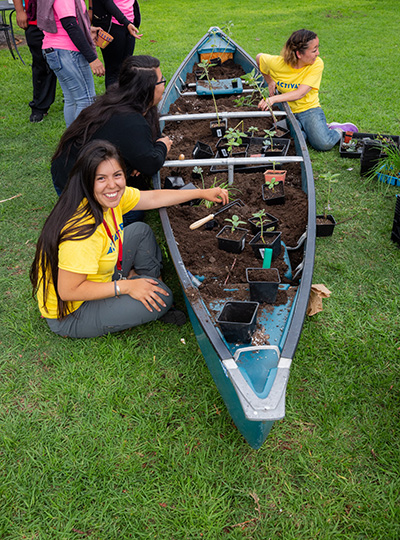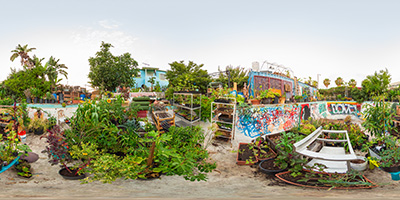Ron Finley is an metropolis gardener and dressmaker using regenerative agriculture to increase entry to healthful meals and convey neighbors collectively in his South-Central Los Angeles group. He has traveled to Denmark, England, Greece, New Zealand, and Brazil; spoken at conferences along with the American Public Gardens Affiliation; and delivered a 2013 TED Focus on that garnered 3 million views on the platform website online so far—all to share the story of how starting his private metropolis yard planted a transformative seed in his South-Central Los Angeles neighborhood.
These days, he starred with actress Rosario Dawson in a quick video for Inexperienced America’s Native climate Victory Yard effort. Produces with our ally Kiss the Flooring, the video touts the benefits of starting a regenerative yard.
Regenerative group gardens, he says, can current modern meals for communities the place there’s a dearth of healthful meals outlets. They will carry group members collectively to work in direction of a typical operate. And they also may help cool the native climate and assure your native soil is fertile ample to feed future generations.
Group gardens, he says, are “about sharing and realizing that there’s ample for everybody. That’s about feeding communities, cities, and each other and realizing there’s lots we’re capable of do collectively.”
“Gangsta Gardening”
In 2010, prolonged sooner than he was the quintessential “Gangsta Gardener,” as he calls himself, Finley was merely attempting to maintain his yard whereas regrouping from the Good Recession of ’08 and ’09.
Tired of touring 40 minutes exterior his South-Central neighborhood to get modern produce, Finley decided to plant on his private land. After taking a Faculty of California Cooperative Extension gardening class at L.A.’s Pure Historic previous Museum, Finley began gardening on his parkway—a 10-foot by 150-foot-long strip of land between the sidewalk in entrance of his dwelling and the street that the majority passersby didn’t pay lots consideration to.
When his swaths of celery, tomatoes, broccoli, peppers, melons, and eggplants sprouted, Finley’s neighbors took delight—and the Los Angeles Bureau of Street Corporations took movement.
Whereas Los Angeles residents have the accountability of sustaining their parkways along with their yards, the Metropolis of Los Angeles owns them, and Finley’s meals forest was a bit taller than city’s 36-inch peak prohibit for parkway plantings. So, an enforcement officer knowledgeable him he should decrease the excess vegetation or get a $400 food-planting permit.
Once more in 2003, sooner than Finley had ever envisioned an metropolis gardening movement, he’d planted banana timber on that exact same strip. A neighbor had reported him to city, and he’d been compelled to remove the banana timber. When requested why he decided to plant on the parkway as soon as extra in 2010, given the ordeal he went by way of in 2003, Finley talked about, “on account of it was nonetheless correct.”
This ordinance is why Finley calls L.A. and completely different cities “meals prisons,” as he does inside the 2015 documentary Can You Dig This: “You could develop points in a desert. In a jail, you need permission to do each little factor. That’s why rising meals inside the metropolis is so defiant, because you’re disrupting a system in place.”
In spherical two of his battle in opposition to the Metropolis of Los Angeles, Finley decided to not decrease down the meals forest, and he solicited the assistance of 900 petition signatories to battle L.A.’s parkway ordinance. Finley found allies in Steve Lopez, a Los Angeles Events creator who documented these events in his frequent column, and Councilman Herb Wesson, who argued alongside Finley that South-Central L.A. is vegetable-poor and that Finley’s yard launched much-needed entry.
Though it took Finley an arrest warrant, two courtroom docket dates, and a public listening to, in all places within the span of two-and-a-half years, city overturned the ordinance in 2015, formally allowing L.A. residents to yard on their parkways.
Since then, Los Angeles has developed plans to develop additional metropolis farms and marketplaces to increase meals entry, which is thrilling, nonetheless the question stays: Why is it nonetheless so troublesome to get modern, pure produce in South-Central Los Angeles anyway?
A Paradise inside a Desert
South-Central Los Angeles is a meals desert: a geographic location the place entry to healthful meals selections are terribly restricted or nonexistent. There are in the intervening time 23.5 million people dwelling in meals deserts inside the US. And cities with extreme African American and Latin American populations, along with Atlanta, Chicago, Detroit, New Orleans, and New York Metropolis, repeatedly prime the file of those hit hardest by meals scarcity.
South-Central L.A. has better weight issues expenses than additional affluent neighboring communities like Beverly Hills, Glendale, and Pasadena, which are only a few miles to its north, in accordance with a 2011 study carried out by the Los Angeles County Division of Public Properly being.

L.A. residents get their palms dirty at DaFunction, a gaggle event held by the Ron Finley Mission to have a very good time metropolis gardening. {Photograph} by Jim Newberry.
There won’t be a definitive reply for the stark distinction in meals entry between South-Central L.A. and its neighbors, nonetheless analysis like one carried out by the Associated Press found that out of two,434 US grocery outlets that opened between 2011 and 2015, solely 250 of those outlets opened in meals deserts. So South-Central L.A., like completely different cities all through the nation, has doable been uncared for by grocery retailer builders that anticipate lackluster earnings from low-income communities.
What isn’t exhausting to hunt out in South L.A. is a surplus of fast meals consuming locations, liquor outlets, and vacant heaps, which Finley says are half of an even bigger design he talks about often. His work, he says, objectives to supply people the devices to point out meals deserts into good meals oases.
“This work isn’t merely regarding the yard or meals; it’s about freedom, and previous that, it’s about people,” he says. “I have to current people how one can be free from the designed paradigm by which they suppose that’s the one method they will reside.”
Following his success overturning the gardening ordinance, Finley turned to his life’s work: instructing people pure urban-gardening fundamentals to create a provide of up to date meals for his or her group. In 2012, he launched the Ron Finley Mission—a nonprofit combining coaching, enterprise, and group bonding to nurture the people of South L.A. by way of regenerative, pure metropolis gardens.
Regenerating South-Central L.A.
“HQ,” fast for the headquarters of the operation, may also be the Ron Finley Mission’s flagship yard, which is positioned on Exposition Boulevard and is adjoining to Finley’s personal residence. Taking over about 150 toes, HQ is lush with fairly a couple of fruits, veggies, and herbs along with, lettuce, broccoli, eggplants, potatoes, collard greens, tomatoes, pears, bananas, basil, sage, and mustard, to name a few. Ten-foot tall sunflowers and graffiti murals collaborate in making a soulful neighborhood paradise.
At HQ, Finley and the Ron Finley Mission staff lead gardening programs for the adults and youngsters he’s recruited from the neighborhood.

A panoramic view of the Ron Finley Mission headquarters. {Photograph} by Jim Newberry.
Together with regenerating the realm, Finley and HQ’s gardeners are moreover regenerating the soil. In his gardening observe, Finley abstains from pesticides and fungicides, and retains soil lined with crops, which helps improve water infiltration. He moreover embraces hügelkultur-styled raised soil beds, by which mounds of logs, branches, and compost are topped with soil. As a result of the picket provides decay, they provide nutritional vitamins to that soil and bigger aeration over time.
Finley says he’s grateful to participate in an even bigger ecosystem as a gardener and has witnessed bees, butterflies, and hummingbirds return to his neighborhood. Though regenerative agriculture may be a fairly new time interval, Finley says he’s been doing all of it alongside nonetheless calling it “biomimicry.”
“The forest does regenerative agriculture by itself. So what I’ve carried out is replicate the forest by doing biomimicry,” says Finley, that signifies that he tries to mimic pure rising cycles in his gardens. For Finley, regenerative gardening begins and ends on the soil. As an illustration, he’s devoted to composting—the tactic of taking plant supplies like trimmings, grass, earlier crops, twigs, leaves, and meals scraps and letting them decompose.
“One in every of many points I found gardening and coping with compost is that we’re carbon, and we’re part of the soil,” he continues. “Within the occasion you take a look at compost, a gaggle of points that had been supposedly lifeless, after which see the heat produced from it, it makes you question the place the heat comes from. It reveals that we’re energy, and energy in no way dies; it merely transforms, and gardening makes you understand that.”
Paying It Forward
Finley says he has no idea what variety of gardens he’s helped plant, and though it may be good to know, he isn’t concerned with numbers. What he says is most rewarding is seeing how far his message has traveled and impressed people world large.
“It’s crazy what number of people have gotten into [urban gardening] after saying they’ve heard me converse,” says Finley. “I was in New Zealand not too way back, and Maori elders knowledgeable me they’ve been following my work for years, and I was like rattling. I get to see the fruit of the seed I planted in precise time, and I’m honored by that. I don’t have the phrases to express how that makes me actually really feel.”
In the meanwhile, Finley has plans to hold the final phrase yard experience to life by discovering an even bigger location the place he can embrace not merely the yard nonetheless a café, a greenhouse, and a meals stand the place people can have the power to commerce their additional produce. The Huffington Put up initially reported on Finley’s plan to assemble a yard behind one amongst L.A.’s Carnegie Libraries in 2014, nonetheless he says authorities paperwork is halting the tactic, so he’s exploring personal funding selections.
And he continues to encourage people all through the US to embrace regenerative “biomimicry” methods of their gardens.
“We have got communities nationwide which may be meals prisons that will very properly be producing their very personal pure meals whereas addressing native climate change,” talked about Finley inside the video. “By educating most people about regeneratively homegrown meals, Native climate Victory Gardens are elevating consciousness about considered one of many largest world challenges of our time and displaying People how they will make a distinction for themselves, their households, and their communities. Soil equals life.”
